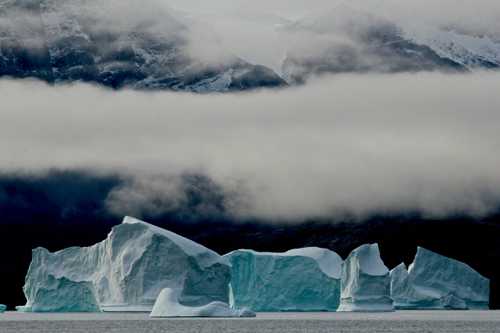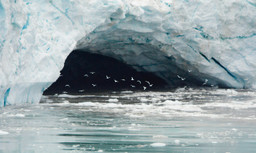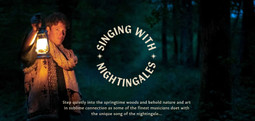
Following our recent article, ‘Eight Pieces of Classical Music Inspired by the Natural World’, we’re pleased to bring you a range of contemporary music which has used nature sounds in a more direct way. Rather than simply drawing on, replicating, or being inspired by the sounds of birds, animals, and insects, or weather conditions, composers and musicians are now able to incorporate those sounds directly into their work by utilizing recording technology unavailable prior to its invention in 1850s France.
Below, then, is a variety of pieces in which sound-recordings are an intrinsic part, ranging from the cries of seabirds to slow-down blackbirds and Arctic soundscapes.
As with the work of more traditional composers, we hope that these works will allow you to hear even very familiar natural sounds afresh, and allow these new perspectives to open up different ways of engaging with the sounds of the natural world, and enrich our consideration of our place in that world.

Einojuhani Rautavaara’s Cantus Arcticus: Concerto for Birds and Orchestra (1972)
The subtitle of this “captivating and deeply moving” work by the Finnish composer is not theoretical: throughout Cantus Arcticus, a conventional symphony orchestra “engage[s] in a constant dialogue” with birdsong recorded by Rautavaara himself near the Arctic Circle and on bogs in the north of Finland. This decidedly unconventional choir includes, in the second movement, the song of a horned lark (“lowered by two octaves to turn it into […] a ‘ghost bird’”), and, in the third, the duplicated cries of whooper swans.
By combining music and birdsong in this way, across three movements which are “by turn dramatic, lyrical and vivacious”, the composer created a “totally successful […] integrati[on of] pre-recorded tape with acoustic instruments”, but one which ultimately offers “no easy resolutions”.
Chris Hughes’ ‘Slow Motion Blackbird’ (1994)
September, 1967: influential American minimalist composer Steve Reich wrote instructions for what he considered a conceptual piece, ‘Slow Motion Sound’: “Very gradually slow down a recorded sound to many times its original length without changing its pitch or timbre at all.” At the time, this was not possible on commercially available equipment.

Five years later, a teenager called Chris Hughes was taken by his father to see a performance of Reich’s mind-bending phase music piece, Drumming. It would take more than 20 years, but in 1994, Hughes – by then a music producer and songwriter himself – released an ambient album, the “clear and sparkling” Shift: From the Music of Steve Reich, which updated fragments of Reich’s work with the use of a “Synclavier utilizing digital drum programs”.
One track, ‘Slow Motion Blackbird’, realized the concept of ‘Slow Motion Sound’, using a recording of the humble blackbird. Combined with a cellist’s interpretation of that call (itself also slowed down), the piece creates a “hypnotic”, “beautifully pastoral and mesmerising work that retains the systems-based integrity of the original idea”.
John Luther Adams’ Earth and the Great Weather: A Sonic Geography of the Arctic (1995)
Earth and the Great Weather forms a northerly counterpart to the Antarctic symphonies featured in our rundown of more conventional classical music – Ralph Vaughan Williams’ 1953 Sinfonia antartica and Peter Maxwell Davies’ Symphony No. 8 from 2001. An epic work, orchestrated for strings and percussion, it also includes not only recorded nature sounds but “no less than five narrators and four languages” (English, Latin, and two Indigenous languages) in order to provide “an impressionistic portrait of the Arctic landscape”, “describing place, plants, and weather”.

Known for work “profoundly influenced by the natural world”, John Luther Adams (not to be confused with plain old John Adams) began his musical career by playing drums in rock bands as a teenager; here, frequently thunderous drumming is based around the rhythms of traditional Indigenous Iñupiat and Gwichʼin music. Adams describes how “Indigenous peoples have long understood the extraordinary powers of certain landscapes. For those of us who have lost or forgotten our intimate connections with such places, the Arctic is a vast and enduring geography of hope.”
In his “painfully beautiful” cycle, the composer takes the listener on “a thoughtful and respectful journey through the implacable Arctic stage which buffets the senses”. Its “graceful string passages, […] punctuate[d] with harsh, bracing percussion trios” – counterpointed by native birdsong, water trickling, and the crunching of ice, embody the sensations Adams experienced when he first visited Alaska (where he was to become a long-time resident): “a kind of exhilaration, a sense of possibility […] that led me to dream of music that somehow reverberated with all of that fire and ice and wind and stone and space and elemental power.”
Richard Blackford and Bernie Krause’s The Great Animal Orchestra: Symphony for Orchestra and Wild Soundscapes, 2014
In 2016, the Fondation Cartier pour l’art contemporain, Paris, staged an exhibition based upon the work of Bernie Krause, American musician and bio-acoustician. Titled The Great Animal Orchestra, it allowed visitors to experience a blend of material culled from nearly 5,000 hours of recordings made by Krause over more than 40 years, of “15,000 species in 2,000 habitats, terrestrial and marine”.
While “offer[ing] a wondrous immersion into wildlife’s acoustic environment”, the symphony of nature sounds was also “visualize[d] […] as animated spectrograms”, allowing “an aesthetic meditation, both aural and visual, on the animal kingdom”. In addition, by showing “the upper registers [of the soundscape] populated by birds and insects, while mammals and natural elements such as wind or water occupy the middle and lower registers, respectively”, demonstrated Krause’s acoustic niche theory: in a healthy ecosystem, “species will avoid competition by singing at unique bandwidths, or pitches, at unique times”.

The blend of nature sounds, which allows listeners to travel through seven particularly ecologically diverse territories – from the Central African Republic and Brazil to the world’s oceans – can be heard here, showcasing “the howls, croaks, hums, trills, clicks, growls, and cries of animals in the wild”. However, 2014’s The Great Animal Orchestra: Symphony for Orchestra and Wild Soundscapes went one better, blending Krause’s recordings with orchestration by English composer Richard Blackford. Here, “microtonal wolves [are] blend[ed] with horns; […] [and] tree frogs’ croaking rhythms bleed […] into [a] percussion combo”. Juxtaposed with the conventions of human music, “the beauty, diversity, and complexity of the animal languages” are revealed, even as they are “slowly silenced by the deafening noise of human activities”.
The piece was released with a reorchestration for symphony, by Blackford, of composer and organist Camille Saint-Saën’s indelible Carnival of the Animals (1886). Across 14 brief movements, “virtuosic depiction[s]” represent various animals and birds musically, from kangaroos (“‘hopping’ chords”) to a swan (gliding piano and cello), and even fossils (Danse macabre-like xylophone).
Sam Lee’s Singing with Nightingales (2021)
This three-track release by Mercury Prize-nominated folk singer, conservationist, activist, and former wilderness survival expert gives a taste of Lee’s passion project of the same name. Singing with Nightingales is a series of late-night concerts given by Lee and a guest musician, where they perform a firelit duet with the unique after-dark courtship song of the embattled nightingale. Taking place for small audiences in the woods of “Sussex, Gloucestershire and beyond”, tickets and further details are available here.

“Neither an ecology walk, a bird-watching expedition, or even a concert […] [Singing with Nightingales] is a work of immersive theatre, staged by nature, told by humans and outshone by a very special bird.” Yet it is also more than that, with intentions to leverage the potential that art and music for “bring[ing] about transformation”, perhaps “re-enchant[ing] ourselves back into a connection with nature”. As such, this “communion with nature” is “at its heart a conservation exercise and operates as an experiential means to create and invite renewed appreciation of an ecological niche under great threat”.
Further listening:
Even without using recordings, some musicians have found other ways to bring nature sounds into their work.
Iannis Xenakis’ Pléïades (1978)
Xenakis was born in Romania to Greek parents, but took French citizenship after the Second World War. As well as being an “avant-garde composer, [he was also a] music theorist, architect [trained under Le Corbusier], performance director and engineer” – and, having harnessed mathematical models for use in pieces such as Pléïades, a composition for six percussionists, he came to be an important influence on electronic and computer music.
Rather than using nature recordings in the work, Xenakis produced the music itself from data generated by natural process, creating a piece “as raw and refreshingly free of human emotions as a mountain or a river”.
Pléïades, “one of the most complex and fiendishly difficult works ever written for percussion”, and “a test for the extreme limits of performers”, is also ‘a lot’ (one interpretation of its title) for the audience: “an almighty force of nature […] [to] take a breathtaking plunge in[to]”, like a waterfall or a storm. In this way, Xenakis uses stochastic theory (“where results can never be predicted”) to create a piece which mirrors the chaotic, overwhelming unknowability of the forces which underpin the natural world. Though the results are in some ways akin to the minimalism of Steve Reich, “Xenakis’ focus was on the subtle dividing lines between rhythmic order and chaos”. As such, where “Beethoven described nature in his Pastoral Symphony, [and] Sibelius was stunned by nature in his Tapiola, […] Xenakis had to come to turn music into nature.”
Terje Isungset’s ‘Ocean Memories’ (2019)
In 1999, inspired by an interest in making sound from natural materials, Norwegian jazz percussionist Terje Isungset pioneered the idea of ‘ice music’ – not music based upon the sounds of ice, but music played on instruments made from ice. The next year, Isungset was commissioned to perform “the world’s first Ice Music concert inside a frozen waterfall in Lillehammer, Norway” – making him the world’s first (and only) ice musician. The year after that, he recorded what would prove to be the first of 10 albums of ice music. Isungset has also established the Ice Music Festival (which has taken place annually since 2006), tours internationally with various offshoot ice music projects, and is the subject of an upcoming documentary, Sound of Ice.
Isungset’s instruments – which range from ice chimes to ice trumpets, horns, guitars, didgeridoos, drums, langeleiks, and even ice marimbas – are carved from the frozen waters of pure Norwegian rivers, lakes, and glaciers. Blocks are extracted during a grueling six-hour process, with the instruments themselves sometimes taking weeks to make. However, their lifespan (as you might imagine) is limited, requiring that “close attention [be paid] to how they need to be handled and the ideal temperatures in which they need to be stored”.
Prompted by the excitement of discovering unforeseen sonic possibilities, Insungset’s “exploration of making beautiful, ethereal sounds from the precious ice” has lasted for 20 years. It is also grounded in his respect for nature and his “first-hand [experiences of] the damaging affects [sic] of global warming”. This year, the Ice Music Festival will stage additional sessions in Greenland, as a way to draw attention to its status as a location “experiencing the effects of climate change at a faster rate than most of the world”, while ‘Ocean Memories’ was recorded for Greenpeace in temperatures of 14 ºF (-10 ºC) in the Svalbard archipelago in northern Norway.
To Isungset, the climate crisis derives from our “lack of respect for nature”, which we should see as “our best friend”: “And if you have a good friend, you have to treat them nice and gently and with respect. It’s very simple.”
Earth.fm is a completely free streaming service of 1000+ nature sounds from around the world, offering natural soundscapes and guided meditations for people who wish to listen to nature, relax, and become more connected. Launched in 2022, Earth.fm is a non-profit and a 1% for the Planet Environmental Partner.
Check out our recordings of nature ambience from sound recordists and artists spanning the globe, our thematic playlists of immersive soundscapes and our Wind Is the Original Radio podcast.
You can join the Earth.fm family by signing up for our newsletter of weekly inspiration for your precious ears, or become a member to enjoy the extra Earth.fm features and goodies and support us on our mission.
Subscription fees contribute to growing our library of authentic nature sounds, research into topics like noise pollution and the connection between nature and mental wellbeing, as well as funding grants that support emerging nature sound recordists from underprivileged communities.

